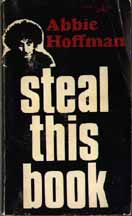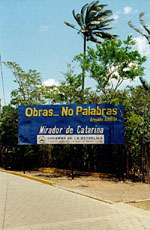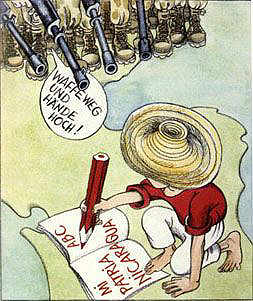November 2002
Steal This Book
“Leaflets, posters, newsletters, pamphlets and other printed matter are important to any revolution. A printing workshop is a definite need in all communities, regardless of size. It can vary from a garage with a mimeograph machine to a mammoth operation complete with printing presses and fancy photo equipment. With less than a hundred dollars and some space, you can begin this vital service. It’ll take a while before you get into printing greenbacks, phony identification papers and credit cards like the big boys, but to walk a mile you must start with one step as Gutenberg once said.”
...
“Food conspiracies, bust trusts, people’s clinics and demonstrations are all part of the new Nation, but if asked to name the most important institution in our lives, one would have to say the underground newspaper. It keeps tuned  in on what’s going on in the community and around the world. Values, myths, symbols, and all the trappings of our culture are determined to a large extent by the underground press. Each office serves as a welcome mat for strangers, a meeting place for community organizers and a rallying force to fight pig repression. There are probably over 500 regularly publishing with readerships running from a few hundred to over 500,000. Most were started in the last three years. If your scene doesn’t have a paper, you probably don’t have a scene together.”
in on what’s going on in the community and around the world. Values, myths, symbols, and all the trappings of our culture are determined to a large extent by the underground press. Each office serves as a welcome mat for strangers, a meeting place for community organizers and a rallying force to fight pig repression. There are probably over 500 regularly publishing with readerships running from a few hundred to over 500,000. Most were started in the last three years. If your scene doesn’t have a paper, you probably don’t have a scene together.”
...
“A heavier scene than even the high schools exists in No-No Land of the military. None-the-less, against incredible odds, courageous G.I.’s both here and overseas have managed to put out a number of underground newspapers. If you are a G.I. interested in starting a paper, the first thing to do is seek out a few buddies who share your views on the military and arrange a meeting, preferably off the base. Once you have your group together, getting the paper published will be no problem. Keeping your staff secret, you can have one member contact with someone from a G.I. coffee house, anti-war organization or nearby underground newspaper. This civilian contact person will be in a position to raise the bread and arrange the printing and distribution of the paper. You can write one of the national G.I. newspaper organizations listed at the end of this section if you are unable to find help locally. The paper should be printed off the base. Government equipment should be avoided.”
...
“Under FCC Low Power Transmission Regulations, it is legal to broadcast on the AM band without even obtaining a license, if you transmit with 100 milliwatts of power or less on a free band space that doesn’t interfere with a licensed station. You are further allowed up to a 12-foot antenna or the use of carrier-current transmission (regular electric wall outlets). Using this legal set-up, you can broadcast from a 2 to 20 block radius depending on how high up you can locate your antenna and the density of tall buildings in the area.”
...
Free food, housing, education, and independent media. Shoplifting, pipe bombs, medical care, draft counseling... and graphic design.
It’s all there in the hipster slang of 1970. While downloading the complete Steal This Book as one big 413 Kb HTML file, read a little about its provenance.
The title joke still makes me laugh. Steal this book about destroying capitalism. But, while some items in the book are still relevant to movement building and perhaps real social change, others seem more like cheap thrills than liberation. 30 years later, Hoffman’s catalogue of techniques of resistence reads as a vision of a life of struggle. The introduction breezes through a snapshot of the ills of America, but get your nuanced political and economic analysis elsewhere — this is just a practical guidebook. Perhaps for those without a nuanced political or economic analysis? “The purpose of part two is not to fuck the system, but destroy it.” By fighting violence and theft with violence and theft? And then what?
Found via Boing Boing.
Donate Your Cell Phone
Upgrading to a new cell phone? Don’t throw out your old one! If you live in the U.S., send it to Call to Protect.
“Call to Protect is a national wireless phone collection drive designed to provide domestic violence victims and organizations with one of the most powerful tools in the fight against domestic violence... a wireless phone. The program is a partnership between the Wireless Foundation, the National Coalition Against Domestic Violence and Motorola who have worked together since 1996 to provide free phones to victims of domestic violence through the program.”
Free emergency airtime is donated by wireless service providers. Check the FAQ.
American Concentration Camps

Blamed for an attack on America, non-white Americans and residents of foreign descent had become so hated that in February 1942 the President ordered their arrest and detention at “relocation centers” around the country. 110,000 men, women, and children were removed from their homes, rounded up at gun point, and locked up for the next three years.
From a Web site on Owens Valley History, the site of the Manzanar detention center:
“Two-thirds were first-generation American citizens. They lived in American cities, attended American schools, and thought of themselves as Americans... They were removed from their homes, schools, and businesses, and brought to Manzanar and nine other camps like it.... A few were second-generation Americans.... Neither they nor their parents had ever known any other life than their life in the United States.
Almost a third of the prisoners were Japanese citizens, resident aliens by definition of the U.S. immigration law.... All of this group had lived in the United States at least eighteen years, since American borders were closed to Japanese immigrants in 1924. All had been specifically barred from applying for American citizenship. The right to become an American citizen was not allowed to the Japanese until 1952, when quotas were introduced.”
The Library of Congress Web site features a collection of 244 photographs of Japanese-American internment at Manzanar taken by reknown landscape photographer Ansel Adams. Depicted are scenes of daily life, agricultural scenes, sports and leisure activities, and portraits of the detainees. Browse via the subject index or the thumbnail view.
From the Library page about the collection:
“In 1943, Ansel Adams photographed the Manzanar War Relocation Center at the suggestion of its director, his good friend and fellow Sierra Club member, Ralph Merritt. Adams wanted to contribute to the war effort while at the same time show the loyalty of the Japanese-Americans interned at Manzanar... In 1944, some of these images were published in Adams’ book Born Free and Equal. The book had a limited circulation, perhaps due to the political climate of war-time America. When offering the collection to the Library, Adams said in a letter, ‘All in all, I think this Manzanar Collection is an important historical document, and I trust it can be put to good use...The purpose of my work was to show how these people, suffering under a great injustice, and loss of property, businesses and professions, had overcome the sense of defeat and despair by building for themselves a vital community in an arid (but magnificent) environment.’”
The internment camps were small planned communities built with volunteer, contract, and forced labor on the site of a ghost town.
“The center was located at the former farm and orchard community of Manzanar. Founded in 1910, the town was abandoned when the city of Los Angeles purchased the land in the late 1920s for its water rights. The Los Angeles aqueduct, which carries Owens Valley water to Los Angeles, is a mile east of Manzanar.”
In addition to vital necessities of food and shelter, the camp had its own school, church, factories, hospital, and even a local paper. See this essay for details on the design and operations of the camp.
 40 years after the closing of the camps, the United States government conceded that the relocation was based on racial bias rather than on any true threat to national security. 50 years later in 1992, President Bush offered reperations and an apology.
40 years after the closing of the camps, the United States government conceded that the relocation was based on racial bias rather than on any true threat to national security. 50 years later in 1992, President Bush offered reperations and an apology.
Congress established the Manzanar National Historic Site, containing 550 acres, on March 3, 1992. It is currently administered by the National Park Service, under the U.S. Department of Interior. See the Park Service Web site.
Nearly 60 years after the war, Yoshie Hagiya, age 77, Oxnard High class of 1942, received her school’s valedictorian honors.
Murals and Anti-Murals in Nicaragua
Two years ago I spent my birthday in Nicaragua. I was traveling with a delegation organized by Peaceworks, meeting with local groups and learning about the country and its struggles. As the eight of us bounded along the dusty roads in the back of a white pickup truck, one could periodically spot these odd abstract murals along walls and fences. They were vertical, horizontal, and diagonal stripes in pastel colors. It turns out the stripes had been painted over Sandinista slogans and murals under orders from right-wing President Arnoldo Aléman. See Nicaraguan Murals 1930-2000 on the Stanford site for a hint of what was lost.
The painted stripes reminded me of Sol LeWitt and Sean Scully. A fizzy gallery world rhetoric of geometry instead of engagement with the world at large. And that’s just the way the CIA likes it. From the Monthly Review:
“[The] CIA and its allies in the Museum of Modern Art (MOMA) poured vast sums of money into promoting Abstract Expressionist painting and painters... What the CIA saw in Abstract Expressionism was an ‘anti-Communist ideology, the ideology of freedom, of free enterprise. Non-figurative and politically silent it was the very antithesis of socialist realism’. They viewed Abstract Expressionism as the true expression of the national will. To bypass right-wing criticism, the CIA turned to the private sector (namely MOMA and its co-founder, Nelson Rockefeller, who referred to Abstract Expressionism as ‘free enterprise painting.’)”
See also articles in Salon and the New York Times.
Needless to say, the CIA also poured of money, weapons, and comics into toppling the Sandinistas.

 We rode through the streets paved with hexagonal ‘Somoza bricks’ crumbling from the wear and tear. The Somoza government had laid the bricks, having purchased them from factories he also owned.
We rode through the streets paved with hexagonal ‘Somoza bricks’ crumbling from the wear and tear. The Somoza government had laid the bricks, having purchased them from factories he also owned.
These stark blue billboards were everywhere. “Obras No Palabras” painted in the same yellow italic sans serif and listing some local government financed project. “Works not Words,” a kind of anti-propaganda propaganda promoting the good will of the State and attempting to short-circuit debate.
And indeed, Aléman’s works have spoken loudly. This past September, Nicaragua’s Attorney General charged Aléman and 13 members of his family and former administration “with money laundering, fraud and other crimes.”
I bet he never saw that coming from his own former vice-president.
Design for Democracy
Misleading ads, voter intimidation, malfunctioning and confusing ballots... problems continue to plague U.S. elections. And designers are starting to step up.
Design for Democracy is an non-profit organization in Illinois . It’s mission is to:
“Improve the informational and physical systems involved in the American voting experience through education and user-centered research, evaluation, strategic design, and implementation, in order to support an environment in which every voter counts.”
 From the about page:
From the about page:
“The team is national. Our focus is local. We approach election issues with a unique perspective: as designers. To do that we have specialists in graphic design, industrial design, interface design, Web site development, anthropology, and usability, all of whom understand the human factors in the voting.
We are objective and independent, and we are valued for our ability to consider all possible solutions without preference to a particular technology, ideology or organization. Our commitment is to the public good and we adhere to standards and practices that preserve our client-focused point of view. Our recommendations and the materials we create will be based on meeting election code requirements and understanding what will be easily implementable by those who operate elections.
Design for Democracy... is not aligned or associated with any corporations, organizations or entities that advocate a specific voting product or service.
Design for Democracy works directly with election officials in both large and small jurisdictions to maximize their resources and achieve specific goals.
For large jurisdictions, we can comprehensively study singular issues and determine areas for improvement in processes, procedures and materials. Then we can apply our knowledge and experience to recommend and implement those improvements.
With smaller jurisdictions, we can apply proven strategies and solutions, including templates that can be easily adapted to a particular need. These templates have already been used successfully in two Cook County, Illinois elections.”
Affiliated organizations include the Industrial Designers Society of America, the American Institute of Graphic Artists, the Usability Professionals Association, and the University of Illinois at Chicago.
Thus far they’re primarily active in Chicago, with a project in Oregon. After a proposed redesign of Chicago’s butterfly ballot, the group then worked to change the Illinois Election Code to implement the redesign and legally allow the use of lowercase letters in candidate names. Student projects include the design of a more universally accessible voting booth and a more efficient document handling system.
Also, the nod to “user-centered research” in the mission statement refers mainly to field research and documentation rather than actual participation by voters and poll workers in the design process. At minimum, the usability professionals should be able to incorporate user feedback and testing into the process rather than just at the initial data gathering phase.
Once the voting process is redesigned, a hard look at how design can facilitate public participation in other processes (such as candidate making, ballot initiatives, campaign financing, city planning, etc.) would be much welcome.
Otherwise, this seems like a good first step towards engaging designers in civic affairs.
A follow up to this brief blog item on ballot design from May 2002.
Posters for Workers (and the People Who Employ Them)
“Some of the statutes and regulations enforced by agencies within the [U.S.] Department of Labor require that notices be posted in the workplace. The Department provides electronic copies of the required posters. Some of the Department of Labor’s posters are available in languages other than English. They are also available in electronic form.”
More are not very beautiful and seem designed by bureaucrats, but they must be posted in a conspicuous place as a notice to employees and a warning to employers. The posters implicitly call on employees to monitor the complience of their employers, and some even provide phone numbers and contact info. They are designed in a no-nonsense institutional non-style, that speaks of authority and bureaucratic indifference.
Are you a confused employer? The Department of Labor even has an online an electronic walkthrough of the poster requirements and laws.
Many states have their own posters and requirements, too. The posters generally fall into the following areas: minimum wage and age, job safety and health, information about emergency family medical leave, worker’s compensation, and polygraph and equal opportunity protection.
None of the posters I found address your federally protected right to organize and form a union in your workplace — though South Carolina, a “right-to-work” state, describes this right in their big labor law poster.
Below are a sampling of posters produced by the states.

In addition to their statutory language version, Oklahoma provides a plain language version (shown), complete with color photos and clear subject headings.

Tennessee’s poster for employees offers a loud warning for those would forget their rights.

Child labor law == happy kids. Just like in the clip art of this Kansas poster.

Hawaii’s posted is clear and direct, with a splash of color.

Because the information on this South Carolina poster is so organized, I don’t think the poster was consciously designed to be obscure. But what employee would read such a dense poster in the kitchen?
There are also companies who market compliance, selling laminated, redesigned, all-in-one versions of the posters.
Antiimperialistisch Solidaritat

Like the international solidarity work of Cuba, the government of East Germany
“strongly advocated for anti-imperialism and declared general freedom and solidarity with numerous countries including Chile, Uruguay, Vietnam, Laos, Angola and Palestine among others up until the fall of the Berlin Wall in 1989.”
Transnational Poster Art: International Solidarity and East German Poster Art is an online exibit of over 30 posters
“all of which were designed in the former German Democratic Republic (GDR), and whose production was funded and encouraged by the East German government. The viewer will also encounter some posters produced in Nicaragua and Chile which compliment the East German ones in terms of content, and other types of artwork created by Germans as well as Latin American citizens. Our purpose is to show the GDR’s foreign policy towards developing countries during the 1970’s and 80’s, a foreign policy which the East German government strove to reinforce and legitimize through this popular art form.”
 The introductory essay proposes that in addition to this legitimation, the posters fostered an awareness of international political situations, reminded the East German population of communist movements around the world, reinforced the idea of the U.S. as a common enemy to those movements, and that the foreign policy (and its promotion) were also an effort to “one up” West Germany and to gain approval and clout from the Soviet government.
The introductory essay proposes that in addition to this legitimation, the posters fostered an awareness of international political situations, reminded the East German population of communist movements around the world, reinforced the idea of the U.S. as a common enemy to those movements, and that the foreign policy (and its promotion) were also an effort to “one up” West Germany and to gain approval and clout from the Soviet government.
The posters are organized as follows:
- History: GDR Poster Art
- GDR Poster Art and Chile
- GDR Poster Art and Nicaragua
- GDR Poster Art and other Latin American Countries
- GDR Poster Art and other Developing Nations
- Anti-USA Posters
The poster up top is by Alexander Schiel, titled “‘In our hands, God has put the destiny of a troubled humanity.’ — US President Reagan,” 1983. The poster on the right is “Untitled (Literacy),” 1984, by Barbara Henninger. The American troops are saying “Drop your weapons and put your hands up high!” to the Nicaraguan boy, learning to write, spells out “Nicaragua my mother country.”
Other East German poster art and propaganda can be found at the German Propaganda Archive, see
- Caricatures from Eulenspiegel, the GDR’s weekly humor magazine, 1953
- Posters from the 30th anniversary of the GDR in 1979
- Eulenspiegel cartoons, 1985-1989
- Labor related propaganda from workplace Wandzeitungen — bulletin boards or “wall newspapers,” 1988 and 1989
Shit Power
Now here’s a renewable energy source. From the BBC:
“Britain’s first dung-fired power station... the pioneering £7.7m complex, at Holsworthy, north Devon, has won the UK Euro Solar award for 2002 for its builders, German-based Farmatic UK.
The plant runs on around 1.6m tons of slurry collected each year from 30 local farmers. At full capacity, it will produce around 1.4 megawatts of power.... Slurry is fermented in two digesters and produces methane gas to power turbines to produce electricity. The plant’s processes also produce hot water for domestic use....
Dung-fuelled power stations are popular in both Germany and Denmark, with about 20-large scale plants operating in each country.”
A quick Web search turned up bio-gas initiatives in Oregon, Kobe, West Bengal, Tanzania, Nepal, and Minnesota. I couldn’t find much about bio-gas power in an urban environment, but just imagine the raw material available every day from, say... Manhattan?
You may also remember bio-gas in a post-petroleum world from such films as Mad Max Beyond Thunderdome, 1995.
BBC article found via Boing Boing.
Center for the Study of Political Graphics
“There has never been a movement for social change without the arts — theatre poetry, music posters — being central to that movement. Political posters in particular are powerful living reminders of struggles worldwide for peace and justice. Communication, exhortation, persuasion, instruction, celebration warning: graphic art broadcasts its humanity through bold messages and striking iconography.
The Center for the Study of Political Graphics (CSPG) is a nonprofit, tax-exempt educational archive that collects, preserves, documents, and exhibits domestic and international posters relating to historical and contemporary movements for peace and social justice....
The archive includes more than 35,000 posters produced in a staggering array of visual styles and printing media, dating from the Russian Revolution to the present. University, museum, and public collections of this material are rare, and because those that do exist are seldom accessible to the public, CSPG’s commitment to continually exhibiting this rich visual and social history is so critical....
The Center was recently awarded a major grant from the Getty Grant Program to implenient a state-of-the-art electronic cataloging system designed to make the collection even more accessible.”
I do hope “more accessible” includes publishing more of their collection online. On the CPSG site, the exhibit Presidential Rogues Gallery: Satrical Posters 1960 - Present features a mere 11 images. The Sixties Project has published another of the CPSG’s exhibits online. Decade of Protest: Political Posters from the United States, Cuba and Viet Nam 1965-1975 features 67 posters that were shown at the Track 16 Gallery in Santa Monica in 1996.
Though the center limits its collection to posters from peace and justice movements, a thorough study of propaganda technique would also include material from a right-wing point of view. Movements for peace and justice would also do well not to ignore grassroots conservative movements, their history and political graphics.
The image above is copyright 1971 by the Committee to Help Unsell the War, “a coalition of over 30 advertising agencies.”
Securing the Homeland through Culture
 “[The Homeland Security Cultural Bureau] is protecting the interests of the country’s national security by employing efforts to direct and guide the parameters of cultural production.”
“[The Homeland Security Cultural Bureau] is protecting the interests of the country’s national security by employing efforts to direct and guide the parameters of cultural production.”
“Which artists and strategies may be most aligned with the agents of terror? Who are the postmodernists and do they really pose a threat? Again, here we present to you a cogent argument for rethinking our culture and for aligning our needs for security with a new relation to art.”
A very official-looking, straight-faced satire site.
See also http://www.whitehouse.org/ and http://www.gwbush.com, two other satire sites. I found whitehouse.org’s Department of Homeland Security page when searching for the real Department of Homeland Security page.




